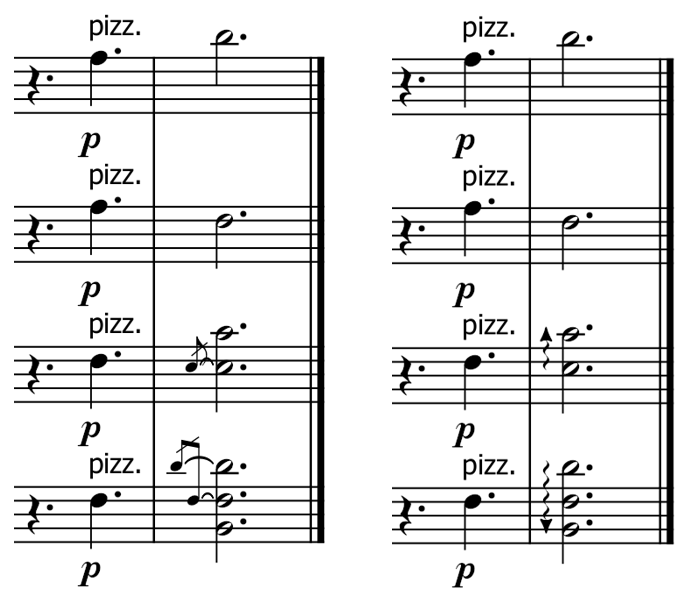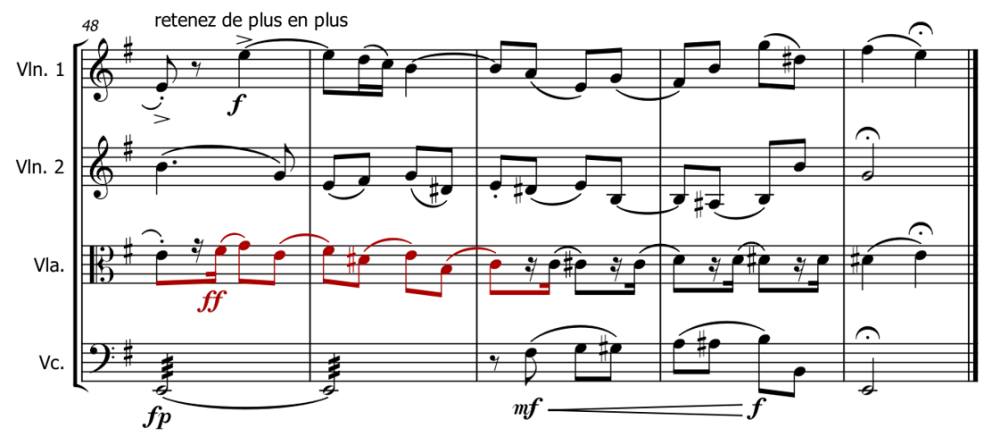-
Posts
19 -
Joined
-
Last visited
-
Days Won
1
林家興 last won the day on August 7 2024
林家興 had the most liked content!
About 林家興

Profile Information
-
Gender
Male
-
Interests
Gardening, numismatics, writing
-
Favorite Composers
Bach, Scriabin, Ravel, Nahre Sol, Poulenc, Fauré, Yann Tiersen, Zhu Jian-er
-
Notation Software/Sequencers
Musescore, paper
-
Instruments Played
Piano
Recent Profile Visitors
The recent visitors block is disabled and is not being shown to other users.
林家興's Achievements
-
林家興 started following Couple of songs if someone could play them for me. , Fantasy on the Royal Road, WIP , I wrote some variations on Dies Irae for string quartet and 7 others
-
Hey all, I've lately become a little sick of writing solo piano music—I did set myself a goal of writing preludes in all the major keys and am nowhere near done—so I decided I wanted to try something new before the new year rolls around? This is my first time trying to write for this ensemble and also the first time I've ventured properly out of my usual idiom (normally Late Romantic/Impressionist with sprinkles of jazz and Asian folk influences). I don't exactly know what genre I tumbled into but I definitely like the general sound I'm getting from it. That being said I am certainly not finished but I figured I'd get some opinions first before I keep going... Cheers!
-
Ah thanks so much @Monarcheon for your comments/feedback/thoughts! It's rare that I get this much to digest in one go, but I'm not complaining if my steak is too juicy and my lobster too buttery. That's a good point you bring up. I did originally want to go for a much longer/expansive theme and variations piece (I think I had this one in mind as the model), but, as a chronic procrastinator, I think I rushed to try to squeeze it in—at the cost of something more substantial—for that competition. Now that that's over and I've realised the futility of arbitrary deadlines, I feel like I can put quite a bit more effort into this. I really like your suggestion about trying to back-engineer extra sections of the theme so I'll be going through my current variations with a fine-toothed comb shortly... Oh yes, I think that'd work very well, I'm gonna put that in! I was thinking something raindroppy for that accompaniment and this definitely suits it. Hmm, I think I see what you mean about the jump, if I presume you're talking about the octave B-to-B? I did think it was a bit iffy when I wrote it so I'm gonna see if I can write a few other versions. Did you mean you felt as if V1 and V2 should convene in bar 5? I'm not sure if this is related, but during my earlier drafting process I did actually think of having all the instruments settle on E in the last bar, so this particular version felt a bit odd to me with V2 falling to G at the end. I'll try expanding the theme and seeing what works best... Yes, definitely, that is what I meant, I seem to have forgotten what that was called! I'll go in and edit that, as well as the rolled pizzicato thing, which I also probably want with the viola. I'm also super happy to hear that b. 21 onwards worked because at the time I wrote it I felt it might have been too disjunct from the rest of that variation. Is it convention to mark a rolled pizz. with an arpeggio line, or something else? I probably want the viola and cello in contrary motion, with the viola up (with the regular arpeggio marking or the one with the arrow), the cello down, and the violins coinciding with the last note only. I like the first option à la Scriabin's Eighth Sonata, but I'm not sure if that might be misinterpreted: Also one of the things I noticed! I remember coming up that rising chromatic line and really digging it, but I must've forgotten that I was tiptoeing around the dominant in the other instruments. Although I'm pretty sure I liked the dissonance that came out of that, the resolution didn't seem very satisfying...I did a small shuffling around that probably works better? I'm certainly the least satisfied with this variation—maybe because I churned it out the fastest, lol—and I agree with your sentiment on the tremolo, contrast, etc. I thought the transitions into the B section and from the B section back into the tremolo were particularly poor, so that'll also need redoing. I'll probably rework it to give it more of a Prestissimo finale/final movement feel (I have a feeling I want to keep this as the last variation and fill the other variations in between) and give more time for the flittering to settle in before moving onto the slow B section, which I thought probably came in too early. Time to get cracking once all my exams are over...
-
Variations on Dies Irae.mp3 I haven't quite been feeling the compositional drive recently, but I did try writing something for one of the informal group competitions over on MuseScore that I'd thought I'd share here as well. I would have definitely liked to write more variations but I was kinda lazy and went with three, which I hope contrast well with each other. I'm always revising my work, so is there anything that you like/dislike about this? As a pianist, I'm also not good at composing for string instruments (this is my...second ever attempt at a string quartet work?) and would be happy to receive feedback on my string writing too! I feel like I may have been too enthusiastic with the slurs and probably should remove a bunch of them... Variations on Dies Irae.pdf
-
The harmony and colours I get from this are gorgeous (bar 12 tickles my brain, but all the movements from chord to chord are exquisite), as well as the appearance and disappearance and reappearance of that 'swinging-pendulum' motif, as Henry pointed out. I'm getting extra ideas for what other textures to put in my slow movements with what you've presented in b. 40 🙂, and I have to say that the piano strings from b. 52 onwards are an excellent touch. Seeing that this is just an intermezzo, I'm sure the other movements are just as interesting! I wonder how this fits into the ballet...
-
Hey everyone, I wrote a short work based on a particular rocking-up-and-down figuration that I liked while improvising. I guess it's a little bit like an étude w/ respect to technique but I also thought the almost perpetuum-mobile right hand gave it a somewhat toccata-esque feel as well. Hope you find it interesting; and if you have any suggestions/critiques/general comments I'd enjoy reading them!
- 1 reply
-
- 2
-

-
A very sprightly waltz that I quite like (and I also think A major/F# minor are pleasant keys to work with, esp. on the piano). I enjoyed the syncopation and a lot of the forward momentum seems to come from the whirring quaver accompaniment or melody. The majority of the waltz seems to hover around the same energy level which slightly put me off (perhaps that's also a consequence of the Noteflight soundfont lol but I'll disregard that), esp. given the work's length and repeats. I would perhaps appreciate more contrast between the different sections i.e. varying dynamics, maybe a slower middle section, or the piece moves into a more distant key; but that's entirely up to the composer and if you have a vision, then it's all yours. I think you broadly did a great job composing for piano as a non-pianist! I don't have many gripes with the technicality or difficulty of the work, perhaps apart from the fact that the constant quaver motion might get a little tiring without a more settled middle section, although that's probably more so for the stamina of the pianist. Some of the five-note chords are certainly comfortable (e.g. 2nd bar, beat 3, right hand; I would take A and B with my thumb, D and E with my index, and the top A with my pinky) but others are a little less so (for the left hand in that same position in the bar, I could either play each note with one finger, which is a little uncomfortable, or try using my pinky and third finger to play two notes each, which are usually the pianist's weaker fingers). Another consideration is when those five-note chords are transposed, the one-finger-plays-two-notes fingering occasionally doesn't work when the two notes are black and white (e.g. bar 65). But, once again, these are only suggestions and a more accomplished pianist could make this work just fine. Thank you for sharing!
-
I tend to try writing very small works when I find myself beset with writer's block, so it is perhaps a bit telling that this is probably the shortest piece I've written to date, and the least like the style I usually compose in. The piece is mainly based off the melody of Brahms' 'Wiegenlied'; that is, if you look at it through a wacky Scriabinesque kaleidoscope infused with altered dominant chords transposing by major/minor thirds or tritones. More broadly, what do you think of it? Was I somewhat successful at reproducing Scriabin's aesthetic (his languid side, at least)? I'm open to other feedback too 🙂
-
There are actually some very pleasant harmonies in this; the way you've voiced the dissonances, with mostly a more open type of spacing, gives them less of that harsh/gritty feel and more of a floating/suspended quality. Although you say it's atonal, sections of it (especially near the start) occasionally seem to wander about a tonal centre, although it is by no means fixed. And kudos for the live performance!
-
Thank you Jorge! I think I'm still trying to find my compositional style (which is a lifelong pursuit), but I think I've settled on what I'd consider a palatable mixture of Late Romantic/neoclassical/jazz (?) influences. The piano soundfont is the free Spitfire Labs Autograph Grand. I occasionally find that the Autograph Grand is a bit too bass-heavy and rather quiet in the upper registers, but it does an okay job; one that performs better higher up is the Labs Soft Piano, which I also sometimes use.
-
Hey everyone, While I've been quite busy with university during the past year, I've started uploading some of my compositions to a YouTube channel, which I think better presents my music as a score-audio combo. They're all still computer renditions, but I hope to begin uploading my own performances these next few months (including of other works, mainly Scriabin). Here's a waltz that I originally wrote for one of those community-organised composition challenges on MuseScore, in which it was required that a note be repeated at least once in every bar of a piece. I ended up bestowing upon it the nickname "Waltz of the B(ee)s" for that reason and gave the score to my music teacher as a gift. Among all of my pieces, I think this is the one I'm closest to recording myself, so I'll update this thread when I'm ready!
-
Haha some very astute observations @Jqh73o! 90% of what I play and listen to is probably Scriabin (slowly weaning off him, however). I made some effort to suppress his influence to see if I could let my personal compositional style roam free, but it looks like might've been a bit too obvious. In terms of quotation, I'm usually quite prudent with what material I choose to pluck and why, but a lot of the time things will weasel their way in subconsciously. The only Scriabin sonatas (is sonate the right plural?) I intentionally referenced were the 4th and the 7th, as you did point out. Of course, I'm a big fan of his majestic climax-restatements, so perhaps I was indirectly inspired by the Allegro de concerto, Sonatas 3-5 and the Fantasy in B minor. I was actually thinking of Kapustin's Sonata 2 when I wrote the repeated-note passages, mainly from the first and second movements, but I can see the resemblance to the 9th Sonata. The introduction with the tremolos and the first theme are both proper references to the opening of Scriabin's Symphony 1. I recall noodling around at the piano with Winkler's transcription when I improvised bars 35-38, which was the first section of this sonata that I came up with.
-
Thanks for your comments @PeterthePapercomPoser! Yeah, bringing audio up to the right volume seems to be a persistent issue with me, especially with tracks and YouTube videos. I usually err on the quieter side in case I blow somebody's eardrums, so hopefully I've corrected the MP3 to be more audible this time around. I'm also glad that the ending and my predilection for ii-V's stood out to you. I indeed tried to make the first and second themes avoid the tonic for as long as possible, mainly to douse the music in some forward momentum and partially because it sounds good. The fact that the second theme modulates from its tonic I to a cadence pointing towards the supertonic was entirely by accident when I was writing it, so when it came to the coda I needed to find a quick fix to move everything back into F major. Naturally, D7 → Gm7 ↔ C9 came easily enough; however, I did want the last two chords to almost blend together into a harmonic cloud of smoke so that quick ii-V alternation melts away. Once I get around to recording it I'll be sure to post a reply to this post!
-
Hey everyone, Just wanted to share a piece that I recently finished. If you'd like some context and a musical breakdown, feel free to pop out the spoilers; if not, have a read/listen and let me know what you think. I'd like to get some feedback on this before I polish up the score!
-

Couple of songs if someone could play them for me.
林家興 replied to Gabriel Carlisle's topic in Piano Music, Solo Keyboard
Did you still need these pieces recorded? I know it's been almost two weeks but I have a nice-sounding digital piano and thought I might be able to help 🙂 -
For context, the waltz that I'm writing currently has a very satisfying introduction (which I borrowed very liberally from the start of Scriabin's 5th Piano Sonata) and a first theme that I'm somewhat pleased with. Attached is what I've jotted down of a second, intermediary theme that I plan to develop later on, as well as some chord labels to track where I want the harmony to go; I'm a little less sure about this secondary theme. I think I've listened to this over and over again so many times that I've gotten quite familiar with it, but does any part of the chord progression feel stilted or weird? For a modulation to C minor, it's probably a bit convoluted. Also, I'm not sure if the melody 'seems' unique enough, or compact enough, even, to be memorable, esp. with its rhythm and contour?





